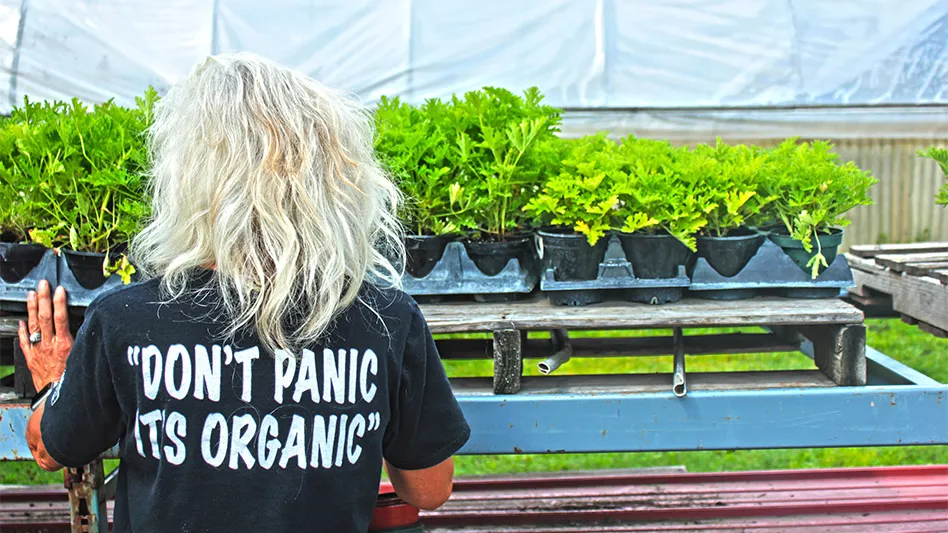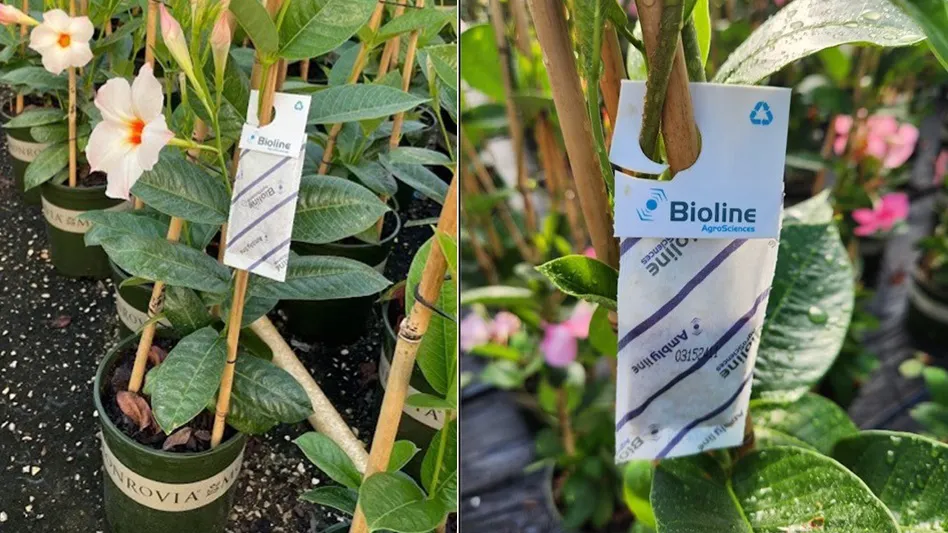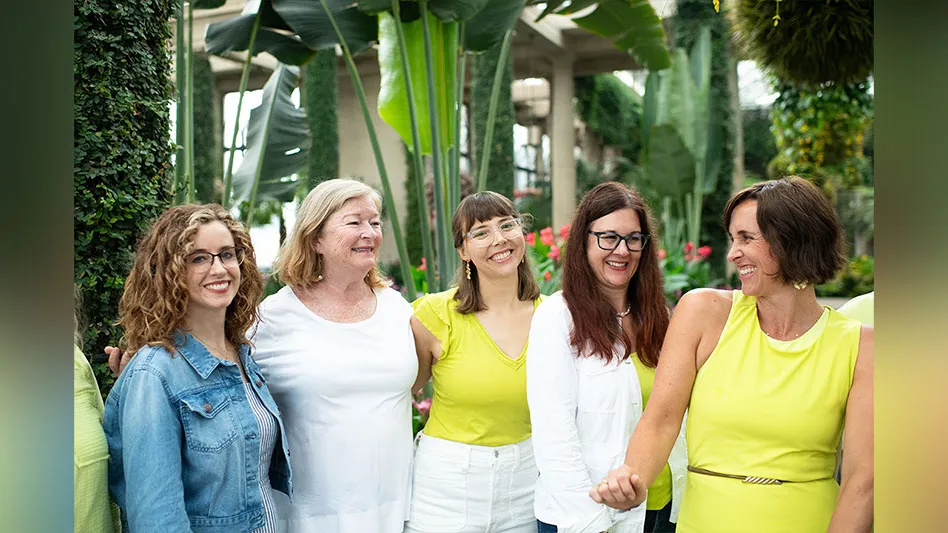

In the broad central walkway of her greenhouse, Cindy Walton turns and gestures broadly. Her fluffy mane of white hair frames bright eyes and a pleasant smile. “This is our newly cleaned greenhouse,” she says with a sense of triumph.
About three-quarters of the greenhouse tables are empty. At the edges, there are a modest selection of herbs, some citrus trees and a cactus display. Still, for a greenhouse, there’s not that much green.
There’s a reason for that. Cindy Walton is the owner of Anthony Petitti Organic Greenhouse in Louisville, Ohio, one of the nation’s few fully organic garden centers, and she recently had a run-in with a pest.
“We had a whitefly issue, and it was just overwhelming,” she explains. “And, you know, I can’t spray crazy things. So we moved every single plant out of our greenhouse. We let it get 120 degrees in there. And then one Saturday night, I hooked up the power washer, and I power washed for two days. Walls, ceilings, floors, every table, I power washed it all.”
And that was just the beginning of the remedy. She applied more heat to the greenhouse and cleaned each plant. However, before going back into the greenhouse, every plant has two additional inspections by separate staff. Most of the absent greenery is still in quarantine.
To say it’s a lot of work would be an understatement. But for Walton, the cost of time and labor is worth it to meet her conviction of operating 100% organic and synthetic-chemical free, which she has done since 2007.
“It is definitely a labor of love,” Walton says. “You know, people say, ‘Oh, you work so many hours.’ And, you know, I do. But I don’t really feel like I’m working because this is my passion.”
Organics rising
Walton isn’t the only one with a passion for organic gardening practices. According to the National Gardening Association’s Garden Research division, the desire for organic gardening products is on the rise among home gardeners.
“The trends are absolutely showing an increase in interest in organic products,” explains National Gardening Association Executive Director Dave Whitinger.
Earlier this year, the group released its annual National Garden Survey capturing the responses of 2,601 households from across the United States. “We ask them, ‘When you think about the lawn and garden products and materials that you purchased last year, how much of it is labeled organic?’” Whitinger explains. Responses available range from all, to some, to none. “In terms of people saying all of it is organic, it’s been trending up for the last five years. In 2019, it was 7%. In 2022, it was 11%.”
But that modest steady growth isn’t only specific to gardeners who are all-in on organics. The trend is also increasing for households who responded that “most” of the garden products purchased were organic — from 19% in 2019 to 22% in 2023. Additionally, those who purchase no organic garden products fell from 21% in 2019 to 15% in 2022.
The growth in purchasing organic products correlates with another trend for home gardeners: use of native plants and gardening for wildlife. NGA data show that the share of those that purchased plants because they were beneficial to bees, butterflies or birds increased from 26% to 35% over the last three years. There was also a 12% increase between 2019 and 2022 in those who purchased plants specifically because they were native to their area.
“I think there’s a crossover,” Whitinger says. “I think people want organics for the food that they’re eating, but people are also concerned about the impact on pollinators. There’s a sense in some people’s minds that growing organically is more environmentally conscious for pollinators.”

There is additional research to back up his supposition. A March 2023 study in the Journal of Environmental Horticulture found that 50% of 2,066 survey respondents could be considered “Native Plant Champions,” characterized by saying that native plants were very or extremely important to their garden. One of the factors that set that market segment apart from those who were moderately interested in native plants or completely ambivalent was the propensity to choose organic products for their garden. Researchers found that those gardeners using organic gardening practices were more than 2% more likely to be Native Plant Champions than those who were not practicing organic gardening.
Organic gardeners are also more likely to feel that synthetic pesticides are a serious environmental concern. A 2020 study in the Journal of Environmental Protection found that among gardeners who adopt organic pesticides, 77% feel pesticide use “is a severe to moderate environmental problem.” The study also found those gardeners were more likely to spend between 10 and 15 hours per month in their garden.
All the numbers add up to a growing population of ecologically minded gardeners who want alternatives to popular synthetic means of fertilization, growing media and pest and disease control. It’s a population that’s willing to spend money with businesses that share their convictions, or, at the very least, offer organic solutions to suit their gardening needs.
“There’s an economic benefit to being environmentally responsible,” Whitinger notes. “I would say, what’s the harm in stocking some organic products? If you don’t stock any organic products at all, you’re not going to know whether your customers want it.”

Saying so long to synthetics
Finding a balance among environmental stewardship, profitability and customer interest has inspired some IGCs to increase the organic products available to their customers. SummerWinds Nursery (#12 on Garden Center magazine’s 2023 Top 100 Independent Garden Centers List), which operates retail nurseries in the Phoenix, Arizona, area and California’s Bay Area, has committed to offering only organic, natural and non-synthetic soils, insecticides, fertilizers and repellents within the next five to 10 years. The changeover is already underway in its eight locations.
The SummerWinds team, including Senior Buyer Jeff Christensen, Vice President of Retail Operations Tim Businda and Senior Marketing and Advertising Manager Shelly Huelsman, count increasing customer interest as one of three main factors inspiring the change. But largely, the team is making the shift to align with the company’s values of sustainability and improve the health of the soil and the planet.
But the shift is not without its challenges. SummerWinds’ slogan is “We Guarantee Success!” Finding organic products that allows it to stand by that guarantee requires a great deal of consideration and research.
“There are natural and organic alternatives to the synthetics we currently carry,” explains Huelsman. “However, in some instances, their effectiveness is not up to our standards. We have to find that balance of doing what is right for the environment while providing our customer with a product that will actually do the job.”
There are additional challenges related to supply. For instance, it’s easier to source products in California, where organics have long been a fabric of the farming and gardening culture. For that reason, SummerWinds’ locations in the San Francisco Bay Area are likely to make the transition to organic products quicker. Arizona locations, however, will need to transition at a slower pace, bringing in acceptable organic products as they become available in the region.
Huelsman notes that it’s been particularly difficult to find organic or natural alternatives in the categories of systemic insecticides and weed control. But she notes that the absence of an alternative will not stop the process. “Five to 10 years down the road, if alternative solutions still do not exist, we will make the move to remove those synthetics from our shelves,” she says. “It’s the right thing to do for our environment.”
It’s important to note that the reasons for an IGC to shift toward offering more organics can be complex and varied. It may not simply be related to ecological health or consumer demand. For Cindy Walton, her organic convictions are built on a belief in personal health and the health of her community.
Walton and her late husband Anthony Petitti started their business after purchasing a landscaping company from her father-in-law in the early 2000s. (The business is unaffiliated with the Petitti Garden Centers group, though Walton’s husband was a fifth cousin of Angelo Petitti). They soon added the greenhouse and garden center. But in 2007, Walton’s father-in-law was diagnosed with cancer, which would ultimately take his life.
“The doctors asked him what chemical company he had worked for, because chemical levels in his body were so high that they really thought that’s probably where it started from,” Walton recalls. The story worried her, and she began to notice cancer was a common cause of death among her garden center colleagues and friends. It seemed the thread that tied them all together could be pesticide use.
Walton’s belief is controversial and difficult to prove outside of anecdotes. For one thing, synthetic pesticides are not invariable. As with any industry, there are constant innovations that shift formulas to make compounds work better and faster. The slow pace of scientific inquiry can make it difficult to monitor the risk of every new permutation. When it comes to synthetic pesticides, fungicides and fertilizers, Walton would rather not take any risks.
“I’m not saying that everyone needs to go organic. It is not for everyone,” she says. “And there are wonderful safety precautions that growers who use chemicals take. But I know me. I’m not going to take those precautions. It’s just better for me if I go organic, you know?”

Cultivating convictions
Between SummerWinds’ long-term organics plan and Cindy Walton’s all-in approach, there are IGCs like Good Earth Nursery and Garden Center in Cream Ridge, New Jersey. Owners Alex Stein and Jenna Krug bought their nursery nine years ago with a vision to use ecologically sustainable growing practices to serve their customers. But those practices didn’t really come into full focus until around 2021.
Stein explains that at purchase, the business was a bit run down. Much of the initial push was to make improvements and bring the greenhouse and garden center back to life. Unfortunately, as new business owners who’d never run a garden center, those improvements required “staying in line with what the previous regime had been doing.”
But Good Earth, and its owners, have matured enough to start bringing the vision into action. “We’re not hyperventilating every night,” Stein says. “It’s a brilliant business. We know what works. We know what we can do. Now, we’re trying to expand into areas that really interest us.”
That interest has led Good Earth to start around 20% of its own plants from organic seed in organic soil. Stein stresses that the remainder of the plants can’t be called organic because they start life with non-organic fertilizer outside of his facility. But once they reach Good Earth, Stein applies “organic practices,” including a strict policy of not spraying synthetics to control pests or disease. Additionally, Good Earth looks locally to stock a large selection of organic products for its customers. Those offerings include Coast of Maine soil and Cow Pots, growing containers made from cow dung.
“Organic just makes more sense to me,” Stein says. “I always thought it was so weird that people will say they enjoy gardening, and then they’re spraying pesticides that are killing all the beneficial insects.”
Stein says he’d like to start and grow a fully organic herb collection, but beyond that, he has no plan to expand organics in his garden center. Space and labor are limiting factors. He simply does not have the time to put in the number of hours that Walton puts into her fully organic operation, and the area he has available to increase his growing operations is limited.
Also, Stein isn’t convinced that there’s enough customer demand for organics to increase his organic offerings. But that doesn’t stop him from having conversations with customers about organic practices. He wants to make sure that his customers understand the difference between organic and non-organic plants and how organic gardening can help them be successful while protecting their local habitat.
“I think customer service is definitely a reason people come here,” Stein says. “We have a lot of one-on-one conversations, especially around the soils. We talk a lot about the soil choices and what the benefits will be and proper fertilizers that we sell that are organic that’ll benefit in the garden.”
Going organic
Cindy Walton walks out of her cleaned greenhouse, and a few startled goats bleat and scamper. Their noise attracts a flock of chickens that strut and cluck, hoping for a morsel to peck at. That’s not particularly strange, considering her greenhouse and garden center abut her organic farm. After all, the animals contribute to the compost, and chickens are famously adept at insect control.
Walton stops at a rack filled with flats of chocolate mint geraniums and citronella. She pets the citronella leaves, and a lemony aroma wafts through the air. She plucks a leaf and rubs it on her skin.
“I love citronella. The more you disturb the leaves, the more it smells, so I always tell people to plant it in a high-traffic area.” She smiles and sniffs her hands. “The cool thing about something like citronella being organic is that you’re more confident to just rub the leaves on your skin and get that natural mosquito repellant.”
It doesn’t really matter to Walton whether customers are clamoring for organic citronella plants. She’s been working this way for 16 years. It’s her standard operating procedure — though she does say that customers will come from as far as Cleveland (a 65-mile journey) or Zanesville (a 95-mile trek) to procure their organic plants for the year.
But for IGCs looking to make an organic leap, faith and conviction may not be enough. It can be a daunting challenge to understand customer desires, what to stock and how to get started.
The first step, according to University of Georgia Agricultural and Applied Economics Associate Professor Benjamin Campbell, is to know your customer. “I get frustrated when I ask garden center owners who their customers are, and they tell me ‘everyone,’” he says. “That shows me you don’t know who your customers are. People are coming to you for a reason. You need to know what it is.”
Campbell was part of a research team that published a 2015 study, “Consumer preferences for organic production methods and origin promotions on ornamental plants: evidence from eye-tracking experiments.” The study looked at the purchasing likelihood of consumers compared to the attention paid to organic messaging on ornamental plants. They found consumers showed a preference for organically produced plants over conventionally produced plants, concluding: “These results indicate that in-store promotions of organic production methods effectively prompt consumers to increase their consideration of those products.”
But Campbell points out that, for consumers, “organic is a state of mind.” He warns that most consumers who are primed to buy organic will do so if given the option. That doesn’t mean that every consumer entering a garden center will have a desire for organic plants. Many simply won’t care, so it’s important to know who is shopping with you and why.

“Generally, people who are buying organic are buying it for a certain reason,” Campbell says. “That reason is they think it’s safe.”
That can also help IGCs understand what to stock. Campbell notes that an organic consumer will likely show preference to organics, regardless of what the plant might be. They’ll be just as likely to buy an organically grown houseplant as they are an organically grown tomato plant.
SummerWinds looked at customer interest before making their shift to organic products. “Customers have been asking for more organic and natural solutions over the past 10 years and increasingly during the past five years,” Christensen explains. “This movement encouraged us to reformulate our private label potting soil and planting mix in 2018 and earned CDFA approval as certified organic.”
Beyond understanding customer needs, there are also considerations of staff training around organics. They are the main customer touchpoint, so it’s crucial they’re providing the best and most accurate information.
Along with daily huddles, SummerWinds has a digital learning solution called “Seeds to Success,” which allows associates to complete interactive online courses that include information about new organic products. There are also two annual product knowledge meetings, where associates can learn from vendor and grower partners.
For her part, Walton encourages her staff to be “eavesdropping sponges.” She often tells her staff, “When I am telling a customer what they should do to control problems organically, you listen to every single thing I’m telling them so that you’ll be able to do the same.”
But she provides direct learning, as well. She also offers education sessions for her staff during winter months and will have them attend classes provided by vendors like Bonide.
Even with staff training and customer insights in place, it can be difficult to know where to start. For those looking to produce more organic plants for their customers, Stein suggests starting from the ground up.
“Figure out what kind of soil you’re going to use,” he says. “There are so many different types of soil. Just because it’s organic, it might not be good for a greenhouse. Make sure what you’re going to use gives you the results you want.”
And for those IGCs that are going to forgo synthetics, Stein encourages owners to have a pest plan in place well before they start. Waiting for a problem to arise before developing a fix is a good way to lose stock, time and money.
Walton encourages IGC owners considering an organic change to start out slow. If they have multiple greenhouses available, she recommends setting one aside where synthetics won’t be used. The plants grown there don’t have to be grown fully organic, but establishing the operating rhythms and management plans will make moving to fully organic growing in that area much easier.
She also recommends IGCs planning to produce their own organic plant material begin with vegetables and herbs. This will help determine a demand for the product. If the response from customers is positive and time is available, effort can be put into expanding organic practices to flowers and houseplants.

Finally, Stein encourages customer education. He notes that any change is going to come with a set of concerns or curious questions, so it’s best to get ahead of them. Perhaps incongruously, that’s particularly true for experienced gardeners.
“There are always new gardeners that are going to have lots of questions,” Stein explains. “But it’s the experienced gardener who you have to convince to do something different. That takes a lot more one-on-one attention.”
Both Stein and Walton say that customers will need particular care when it comes to the price and look of organic plants when compared to their non-organic counterparts. The fact is that a plant started organically may not look as robust as one that was started with a synthetic fertilizer. Customers will need to understand that this will likely change once the plant is in the ground.
When it comes to the price point, Walton helps customers understand the cost of labor. She points out that organic plants require more time and care and sometimes can be affected by pests or disease that require plants to be destroyed. After all, she knows that firsthand. She has a greenhouse full of quarantined plants to prove it.
But Walton wouldn’t have it any other way. Her garden center reflects her passion. And she is clear that passion is required for making an organic change as completely as she has done.
“I would say don’t do it unless it’s a conviction. Because it’s hard,” she says. Back in her greenhouse, she stops for a moment of reflection, smiles and catches tears from the corners of her eyes with her fingertips. “Yeah. This is my calling. Yeah.”

Explore the September 2023 Issue
Check out more from this issue and find you next story to read.
Latest from Garden Center
- Weekend Reading 5/17/24
- GardenComm 2024 Annual Conference registration is open
- Landmark Plastic celebrates 40 years
- Proven Winners introduces more than 100 new varieties for 2025
- Weekend Reading 5/10/24
- The Family Business, Part 2: Agreeing (and disagreeing) on capital investments
- Registration opens for Darwin Perennials Day
- Weekend Reading 5/3/24





